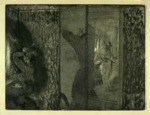
Examples:

Francisco de Goya y Lucientes (Spanish, 1746-1828),
The
Sleep of Reason Produces Monsters (O Sonho da Razao Produz Monstros),
1796-1797, first edition,
number 43 from the series "Los Caprichos", aquatint.
See Spanish art.

Francisco de Goya, Giant, by 1818, XIX, burnished aquatint,
first state; sheet: 11
1/4 x 8 1/4 inches (28.5 x 21.01 cm), Metropolitan Museum of
Art, NY.

Camille Pissarro (French, 1830-1903), Effet de pluie, 1879, etching, aquatint, and drypoint, plate: 6 5/16 x 8 3/8 inches (16 x 21.27 cm); sheet: 9 3/8 x 13 inches (23.81 x 33.02 cm), Los Angeles County Museum of Art. See Impressionism.
![]()

Hilaire-Germain-Edgar
Degas (French, 1834-1917), Actresses in Their Dressing Rooms, 1879-80,
etching
and aquatint, 6 3/4 x 8 1/2 inches (17.1 x 21.6 cm), Los Angeles
County Museum of Art.

Martin Lewis (American, 1881-1962), Boss
of the Block, c. 1939, aquatint
and etching,
Library of Congress, Washington, DC.

Barnett
Newman (American, 1905-1970), Untitled Etching #1, 1969, etching and aquatint, National Gallery
of Art, Washington, DC. See Minimalism
and zip.
Also see ink.
https://inform.quest/_art
Copyright © 1996-![]()